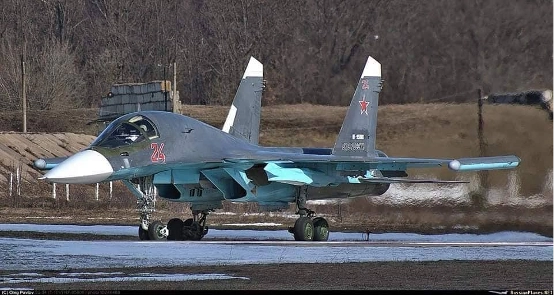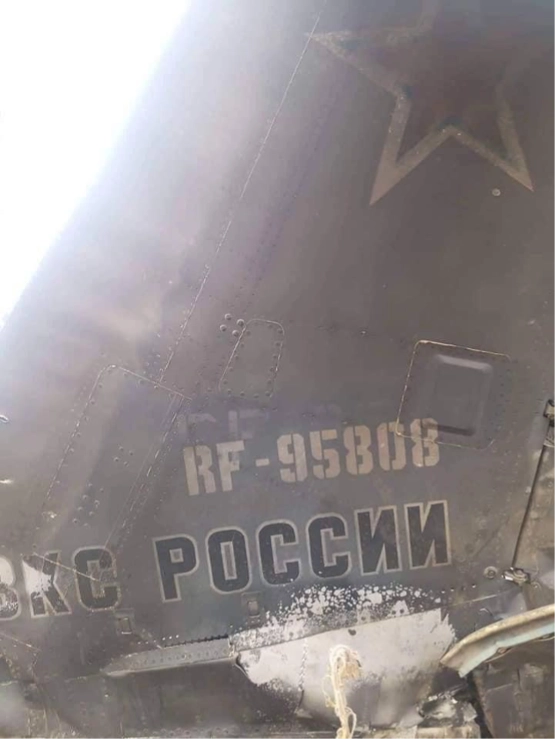The Ukrainian military remains secretive about the recent successful downing of at least thirteen of Russia’s highly advanced jets in the span of just as many days. However, it is widely known that Ukrainian and allied technicians have been studying the remains of various captured Russian airframes and their debris for over a year. Their efforts have yielded valuable insights into overcoming the avionics and electronic defense systems discovered in the wreckage.
Moscow’s prized Mach-2 aircraft, the $42 million Su-34, touted as emblematic of modern combat systems in the Russian military, has been targeted by Ukrainian forces. Despite being considered Moscow’s most advanced and best-protected fighter bomber, the Ukrainian military’s strategic analysis and technical expertise have proven effective in countering this formidable adversary.

Between February 17 and 29, during engagements across the front, the Russian Air Force unexpectedly faced a significant surge in losses of both aircraft and pilots to Ukrainian missiles. As of March 1, the Kyiv kill tally, reported by the Ukrainian military, included the downing of 11 Su-34 attack jets and two more costly Su-35 air superiority jets, each valued at $85 million per airframe.
The heightened Russian losses can be attributed, at least in part, to Moscow’s attempts to advance its troops westward following the capture of Avdiivka. Russian attack jets supporting these assaults found themselves entering air ambushes, a scenario they had previously managed to avoid. According to Yury Ihnat, a spokesperson for the Ukrainian Air Force, this change in tactics played a role in the increased vulnerability of Russian aircraft.
The shoot-down by Ukraine on February 23 of a rare $300 million A-50U AWACS (NATO reporting name: Mainstay) aircraft, coupled with the earlier destruction of another air surveillance and traffic control plane on January 13, had a profound impact on the Russian Air Force’s aerial surveillance capabilities. This significant loss severely hampered Moscow’s ability to monitor the front from the sky and detect incoming Ukrainian anti-aircraft missiles. As a result, the diminished reconnaissance capabilities likely left Russian ground attack pilots operating across the front at times oblivious to being targeted, as highlighted by statements from Yury Ihnat, spokesperson for the Ukrainian military.
In comments made on the national Mi Ukraina television news program on Thursday, a military spokesperson remarked, “The enemy is facing casualties at various locations. Additionally, we successfully shot down two AWACS, and for the past three days, they have been operating without any AWACS support. Despite their increased attacks and advancements, they are now paying the price as they have come closer to our networks.”
Yury Ihnat stated that the Armed Forces of Ukraine possess the Norwegian NASAMS anti-aircraft missile system and the US-manufactured Patriot anti-aircraft missile system, both capable of targeting Russian jets that approach too closely. However, he refrained from disclosing the specific system responsible for shooting down the Russian planes or the methodology employed.
Ihnat elaborated on the capabilities of these systems, mentioning that NASAMS can launch the ground-launched version of the US-made AMRAAM air-to-air missile with a range of approximately 40 km. The American Patriot, recognized as one of the most effective air defense systems in the Russo-Ukrainian War, can engage aircraft up to about 140 km, depending on various factors.
Denying reports that mobile NASAMS or Patriot batteries were involved in the recent shoot-downs, Ihnat argued that once deployed, powerful air defense systems tend to remain stationary.
There are speculations, as suggested by aviation war expert Tom Cooper, that the recent shoot-downs may be linked to a compromise of confidential defensive electronic systems aboard the Russian jets, potentially accessible to Ukrainian and US technicians. Cooper proposed that tweaks made to Ukrainian-operated anti-aircraft systems could leverage this knowledge.
It was suggested that at least one Su-34 airframe may have come into Ukrainian possession early in the war. Cooper highlighted the National Air and Space Intelligence Center as a possible agency for research and countermeasure development. This could involve understanding pilot detection of incoming missiles, identifying frequencies for radar warning devices, and developing countermeasures.
Also Read: Putin: Western Troop Deployment to Ukraine Risks Nuclear War
Compromise of even one electronic defense system could mislead a pilot into a false sense of security, a situation commonly referred to as “flying fat, dumb, and happy” by combat pilots.
Kyiv Post research indicated that at least two Su-34 airframes, both damaged, fell into Ukrainian hands. However, the status of the electronics aboard these planes and whether they were forwarded to NATO avionics experts for evaluation and countermeasure development remains unconfirmed. The first aircraft, identified with the registry number RF-95070, was reportedly captured by Ukrainian forces in the Kharkiv sector in March 2022. The images and reports were published on March 2, 2022, and later republished by the official Ukrainian government platform on March 7 of the same year.

The discovery of the second Su-34 attack jet occurred as Ukrainian troops advanced in the Kharkiv sector in September 2022. The Ukrainian government information platform Operativny ZSU, on September 13, 2022, disclosed that the registry number of the aircraft was RF-94808 and that it had been operated by Russia’s 47th Aviation Regiment based in Voronezh.
Regarding a third Su-34, a video captured its descent to the ground after being hit by a missile on April 25 in the skies near the Kharkiv region town of Balakliya. However, it remains unclear whether this airframe was the same as the one with the registry number RF-94808 or a different one.
In addition to capturing entire aircraft, Ukrainian forces have also seized crucial components that are likely targets for research and countermeasure development. One notable instance occurred in September 2022 when Ukrainian troops recovered an RTU 518-PSM self-protection jamming pod from a crashed Su-30 fighter jet. This cutting-edge defense system is commonly carried by both the Su-34 and Su-35 aircraft. The acquisition of such advanced equipment provides Ukrainian military analysts with valuable insights and potential opportunities for developing countermeasures against Russian aircraft equipped with similar systems.

Yury Ihnat refrained from providing specific details on the new capabilities of Ukrainian air defense systems, emphasizing that ongoing development is a constant in the military landscape. However, he suggested that the recent advancements in Ukrainian air defense might prompt Russian pilots approaching Ukrainian positions to “think twice” before engaging in potentially high-risk maneuvers. This statement implies a potential shift in the strategic balance and a heightened deterrence factor for Ukrainian air defense capabilities.

